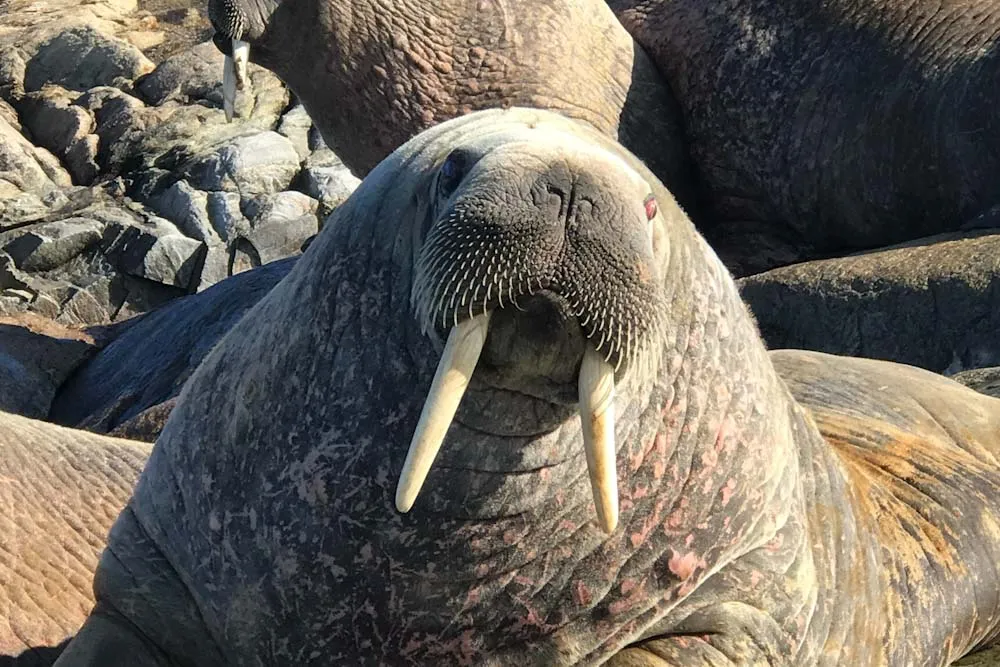Walruses belong to the order Pinniped, which includes organisms that are thought to be some of the most intelligent marine species such as dolphins. Although it is difficult to determine animal intelligence, walrus behavior can be a good indication!
Walruses are considered to be smart because they have been observed to perform many of the behaviors which are good indicators of high intelligence. This includes social mimicry, problem-solving and emotional intelligence.
Keep on reading to hear examples of walrus intelligence. Alternatively, check out my 16 facts about walruses for a broader overview of these iconic marine mammals.
How Smart Are Walruses?
It is difficult to measure how smart animals are because the definition of’ smart’ varies tremendously. When studying animal intelligence, different thing are considered. Some of these include brain size, the number of neurons, brain mass, brain structure, brain organization, brain function, and cell count. Animal intelligence can also be seen as a combination of these factors, and how they process information1 (source: G.B. Bauer, et al., Frontiers in Psychology, 2020).
Pinnipeds (a family which includes walruses and seals) have demonstrated many of the test performances which could determine intelligence. These include short- and long-term memory, imitation, and problem-solving2 (source: F. G. Wood, et al., Dolphin Cognition and Behavior: A Comparative Approach, 2013).
One of the most obvious signs of intelligence in marine mammals like walruses is social learning and group coordination. This is because they are the only mammals, other than humans, which socially mimic each other’s vocalizations and behavior3 (source: G.B. Bauer, et al., Frontiers in Psychology, 2020).
How Do Walrus Communicate?
Walruses communicate with each other in various scenarios, by using a range of techniques. The two main ways walruses communicate with each other are through visual displays (using their physical body) or auditory (the noises they make).
This means that walruses can communicate both on land/sea-ice, and underwater. Communication is a fundamental aspect of mother-calf interactions, as well as adult-adult interactions4 (source: Seaworld).
One way that mothers and calves interact is through physical touch; the mothers often use their flippers to shelter their young. Mothers and calves also recognize each other by the frequency of their voice – which is particularly useful in water and when among big herds5 (source: WWF).
Adult walruses communicate with oneanother using both visual and auditory displays. For example, walrus courtship behaviors include the female physically contacting the male, following a visual display.
However, adult-to-adult interactions are not always friendly. Male walruses will assert their dominance and protect their territory and calves first with visual displays of their tusks6 (source: J.G. MacCracken and R.B. Benter, Marine Mammal Science, Vol. 32, Issue 2, pp. 558-601, 2016). These visual displays will turn physical if they fail to deter the competing walrus or predator7 (source: The Polar Bear Programme). Even female walruses will use their tusks to defend their calves8 (source: WWF).
This means that walruses communication can be affected negatively by man-made noises such low flying aircraft and boat engines. These noises have been linked with hearing loss and reduced survival and reproduction rate in walruses9 (source: WWF).
Can You Train a Walrus?
Yes, walruses can be trained. Walruses have been trained by marine mammal/animal behavior experts to perform a variety of “tricks”. These tricks are often the natural abilities of a walrus, which are encouraged by a food reward.
Some examples of these “tricks” include:
- Making various noises on a cue
- Interaction with toys which are provided by zookeepers (to encourage natural foraging behaviors)
- Various physical tricks including head nodding, lifting their flippers, and moving in and out of the water on demand10 (source: Indianapolis Zoo via YouTube).
Training walruses can also be beneficial to their health and survival within captivity.
For example, one important training aspect is for medical procedures. This training allows zookeepers to monitor the health of the walrus, and ensure they are treated for any ailments they have. More specifically, walruses’ tooths are often capped when placed in captivity, and the walruses are trained to stay calm whilst the tusks are measured to monitor growth11 (source: Indianapolis Zoo via YouTube).
Are Walrus Friendly?
Although walruses are among the top predators of their habitat and therefore are quite dangerous when they want to be, they are also friendly and live peacefully in large herds. For example, around 30,000 were documented across a ∼1 km stretch of beach12 (source: D.H. Monson, et al., PLoS ONE, Vol. 8(7), 2013). Although there are disputes over territory, walruses benefit from the protection against predators.
Walruses use their tusks to visually deter predators, rather than using them to hunt down their prey. Sometimes they have no other option but to use their tusks in conflict. Walruses have also been known to damage ships, and some human-walrus interactions even result in human fatalities13 (source: D.B.MacMillan and W.E. Elmer, Four Years in the White North, 1918).
However, walruses do not hunt humans – a walrus capsized a ship and left with a seal in its mouth14 (source: K. Hansen, Nuussuarmiut, 2008). Walruses also get anxious and retreat when spooked by a predator – they are not blindly aggressive, despite being described as fearless15 (source: The Polar Bear Programme).
Read more about whether walruses are dangerous here.
Related Questions
What is the IQ of a Walrus?
We cannot confidently say what the IQ of a walrus is because these are tests designed for humans and there are even arguments that testing human IQ is flawed in itself16 (source: R.A. Weinberg, American Psychologist, Vol 44, No. 2, pp.98-104, 1989).
Researchers have been unable to design a test that sufficiently captures the scale of behavior and application that an IQ test does. In addition, there is difficulty in administering the test – particularly in the wild17 (source: M. Balter, Science.org, 2015).
Are Walrus Smarter Than Dogs?
Yes, walruses are smarter than dogs when we use average brain weight as the sole indicator of intelligence. Walruses have an average brain mass of 1,020-1126 grams, compared to 72 grams of a dog’s brain.
However, we understand that other factors determine intelligence, so more research is required18 (source: University of Washington).
Are Walrus Smarter Than Cows?
Yes, walruses are smarter than cows based on their average brain weight. Cows have an average brain weight of 425-458 grams, which is less than half that of walruses.
However, more research is required because other factors determine intelligence than just brain weight19 (source: University of Washington).



![Read more about the article How Big Are Walruses? [Size + Weight Compared to Humans]](https://polarguidebook.com/wp-content/uploads/2022/09/Walrus-Size-300x200.jpg)
![Read more about the article Where Do Walruses Live? [With Map]](https://polarguidebook.com/wp-content/uploads/2022/06/Where-do-walrus-live-300x150.jpg)
